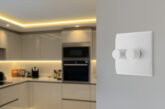
The shift to a low carbon society touches all aspects of the electrical trade, with customer demand for sustainable solutions sitting alongside continually developing regulation. According to the Carbon Trust, lighting accounts for around 20% of all the electricity used in the UK. In an average office building, this figure soars to around 39%, and is even higher in specialised settings such as healthcare facilities (43%) and hotels (55%).
A range of regulations will now seek to address these issues. From September 2023 a range of halogen, fluorescent and low-performing LED bulbs will be removed from sale. As sustainability continues to drive regulatory developments, we can expect further changes to lighting standards as needs and technologies evolve.
For example, last year Part L Building Regulations come into effect, affecting engineers, electrical contractors, consultants, and lighting designers working on non-domestic applications. This is the first time that UK building regulations have incorporated explicit requirements for lighting controls. The core focus for Part L regulations is sustainability; all non-domestic new builds must produce 27% fewer CO2 emissions than previous standards.
According to the Carbon Trust, lighting accounts for around 20% of all the electricity used in the UK. In an average office building, this figure soars to around 39%, and is even higher in specialised settings such as healthcare facilities (43%) and hotels (55%).
Previously, to compensate for lumen depreciation over time, lighting was usually over-specified, and spaces over-lit. This is not only a clear waste of energy but results in uncomfortable spaces which impact users, reducing productivity and user satisfaction. Now, the new Part L2 requirements specify that spaces should not be over-illuminated. Although the new regulations focus on lighting controls to enhance energy savings, they will also be going beyond the use of the traditional energy saving strategies, such as LED lighting and presence detection,, and incorporating the additional benefits that lighting control can deliver to create meaningful impact.
Fundamentally, a control system manages the inputs and outputs of the devices that are part of the lighting system to deliver value that is greater than the sum of its parts. With intelligent lighting control, you can realise multiple energy savings strategies which meet Part L2 lighting regulations, whilst improving the day to day experience of the people using the space.
These energy-saving lighting control strategies can include occupancy/vacancy sensing and daylight harvesting to save up to 60%, personal dimming control gives occupants the ability to adjust the light level and can save up to 20% while load shedding automatically reduces lighting loads during peak electricity usage times, saving up to 50%. Crucially, all of these savings can be realised while elevating high-end design aesthetics and a people-first experience.
An opportunity for superior experiences
Meeting regulations must not mean a depreciation in user experience. Regulations must be met, of course, but compliance is also an opportunity to elevate lighting experiences to create spaces users want to engage with again and again.
In fact, with intelligent lighting controls, facility managers can remotely monitor and adjust levels of electric light and daylight, while reporting and analysing usage, leading to greater efficiency, while impacting occupant experiences. From tuneable white and warm dimming tools to natural light control and privacy options through controllable window blinds, lighting is now a customisable experience.
For example, Sópers House, a new lifestyle office concept in London has used lighting control to offer a nuanced experience that spans professional and personal. With its contemporary office spaces alongside sophisticated co-working environments and health facilities alongside fine dining, next-generation lighting control was critical in realising a morning-to-night vision. Sópers House is just one example of how meeting regulations can go far beyond the tick-box, to offer custom-fit lighting control solutions that create amazing spaces.
Lighting control fit for the future
With the convergence of the internet, smart devices, wireless technology and data analytics it is possible to unlock unprecedented value across the lifecycle. This not only applies to the direct management of the lighting but also the ability to check on the health of the system for predictive maintenance; remote access to regularly optimise the performance of the system; and of course, automation by using multiple sensor types and scheduled events. For example, at Sópers House a considerable amount of money was saved by the control software alerting to an after-hours issue that consumed a lot of energy and provided the team with the tools to fix it.
Today’s state-of-the-art modular, wireless systems go beyond to provide intelligent, flexible switching and dimming control with energy savings via occupancy sensors, daylight harvesting, timeclock scheduling, and demand response – and can flex with changing needs. Now, with intelligent lighting control, the functionality and performance of the system can adapt over time and provide continued updates so additional features and benefits are implemented to improve the value of the system.
Bringing LED lighting and technology together is taking light beyond standard illumination; improving efficiency and adding value throughout the lifetime of a project. By embracing these future-fit solutions now it is possible for installers to meet today’s building regulations and be prepared for tomorrow’s needs, in one smart strategy.
Miguel Aguado, Marketing and Technology Manager at Lutron
For more information, click here









